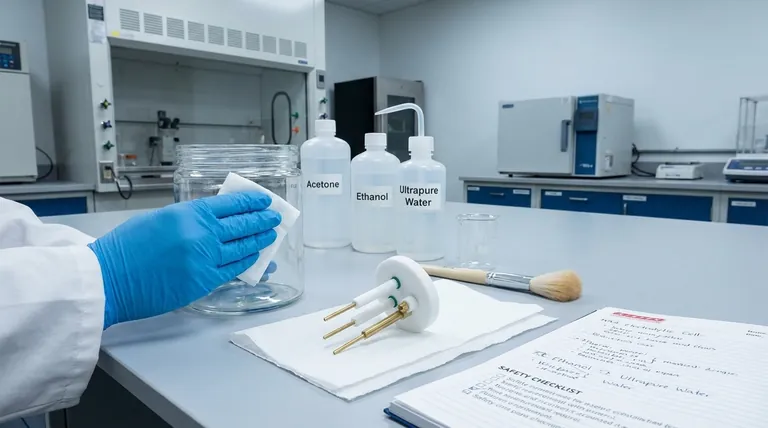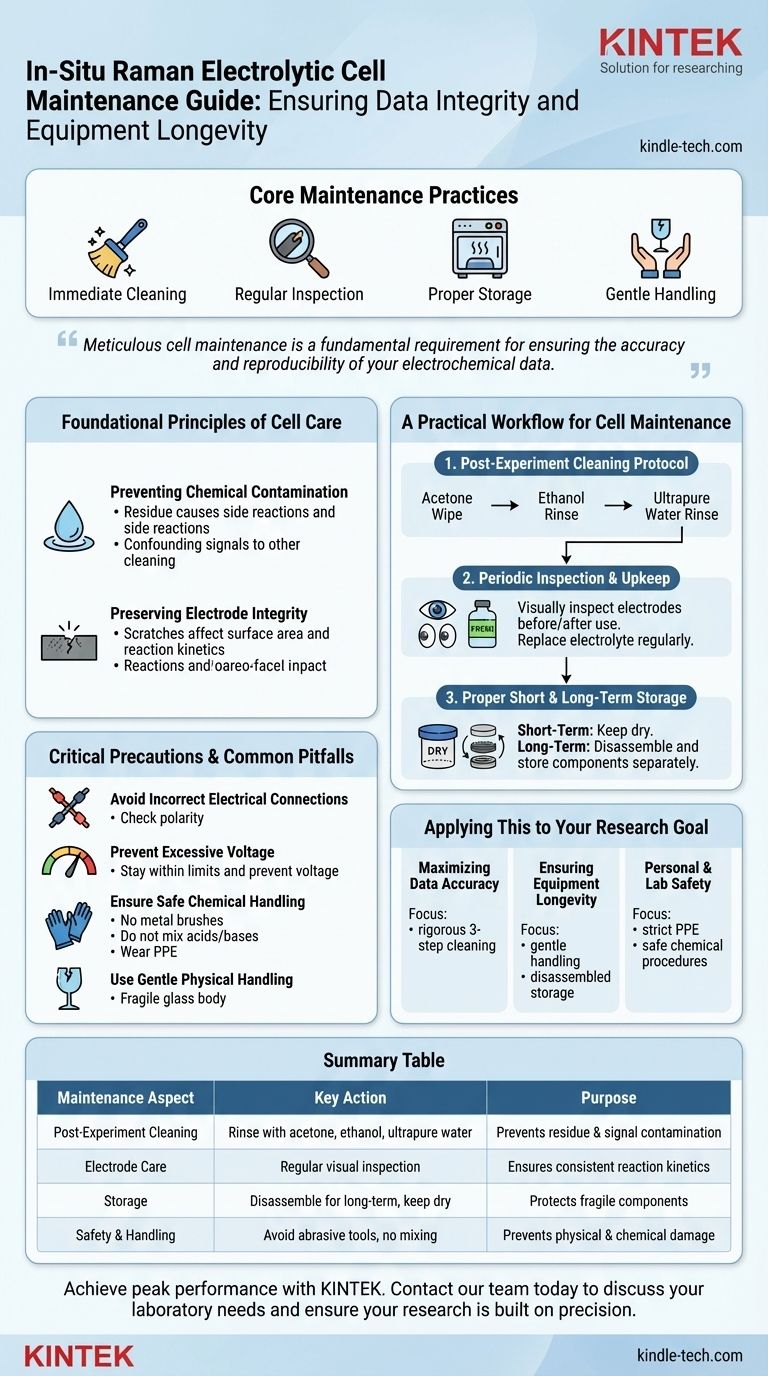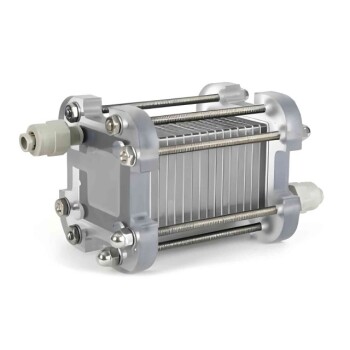Proper maintenance of an in-situ Raman electrolytic cell is critical for both the longevity of the equipment and the integrity of your experimental data. The core practices involve immediate post-experiment cleaning to prevent residue buildup, regular inspection of electrodes, proper storage in a dry environment, and consistently gentle handling due to its fragile glass construction.
The sensitivity of in-situ Raman spectroscopy means that meticulous cell maintenance is not just about protecting your investment. It is a fundamental requirement for ensuring the accuracy and reproducibility of your electrochemical data by eliminating contamination and experimental artifacts.

Foundational Principles of Cell Care
To achieve reliable results, your maintenance strategy must be built on preventing the two primary sources of experimental error: chemical contamination and physical degradation of the cell components.
Preventing Chemical Contamination
Any residue left from a previous experiment, cleaning agents, or environmental exposure can introduce unwanted variables.
These contaminants can cause unintended side reactions or generate confounding Raman signals, obscuring the true electrochemical processes you aim to study.
Preserving Electrode Integrity
The surface of your electrodes is where the critical reactions occur. Their condition directly influences the electrochemical behavior.
Scratches, pitting, or contamination alter the effective surface area and can change the reaction kinetics, leading to flawed or non-repeatable results.
A Practical Workflow for Cell Maintenance
A disciplined, step-by-step approach ensures the cell is always in optimal condition for analysis. This workflow should become a standard lab procedure.
Immediately After Each Experiment: The Cleaning Protocol
The most critical maintenance step is cleaning the cell immediately after use to prevent residues from drying and hardening.
A proven method is to first wipe the inner walls with acetone, then rinse thoroughly with ethanol, and finally complete the cleaning with a rinse of ultrapure water (18.2 MΩ·cm or higher).
Periodic Inspection and Upkeep
Before and after each use, visually inspect the electrode surfaces for any signs of physical damage, discoloration, or contamination.
You must also periodically replace the electrolyte based on usage frequency. This prevents the accumulation of impurities that can affect your measurements over time.
Proper Short and Long-Term Storage
For short-term storage, ensure the electrodes and reaction vessel are completely dry and kept in a moisture-free environment.
If the cell will not be used for an extended period, it is best to disassemble it. Store the delicate electrodes separately, protected from light and physical damage.
Critical Precautions and Common Pitfalls
Careful operation is just as important as cleaning. Mistakes during an experiment can damage the cell, compromise safety, and invalidate data.
Avoid Incorrect Electrical Connections
Always double-check the electrode polarity. Connecting the anode and cathode in reverse can cause irreversible damage to your electrodes and sample.
Prevent Excessive Voltage
Applying a voltage that is too high can lead to the decomposition of your electrolyte or cause permanent damage to the electrode surfaces. Operate within specified limits.
Ensure Safe Chemical Handling
During cleaning, never use metal brushes or other abrasive tools that can scratch the glass cell or the electrode surfaces.
Crucially, do not mix acids and bases (e.g., HNO₃ and NaOH) during cleaning, as this can trigger a dangerous exothermic reaction. Always wear protective gloves and glasses when handling corrosive electrolytes.
Use Gentle Physical Handling
The cell body is made of glass and is extremely fragile. It must be handled with care at all times to prevent cracks or breakage.
Applying This to Your Research Goal
Your specific maintenance focus may shift slightly depending on your primary objective.
- If your primary focus is maximizing data accuracy: The rigorous, three-step cleaning protocol (acetone, ethanol, ultrapure water) is non-negotiable to eliminate confounding signals.
- If your primary focus is ensuring equipment longevity: Emphasize gentle handling and proper long-term, disassembled storage to prevent physical damage.
- If your primary focus is personal and lab safety: Strict adherence to using PPE and following safe chemical handling procedures, especially during cleaning, is paramount.
Consistent, disciplined care of your electrolytic cell is the foundation of reliable and repeatable in-situ Raman analysis.
Summary Table:
| Maintenance Aspect | Key Action | Purpose |
|---|---|---|
| Post-Experiment Cleaning | Rinse with acetone, ethanol, then ultrapure water. | Prevents residue buildup and signal contamination. |
| Electrode Care | Regular visual inspection for damage/contamination. | Ensures consistent reaction kinetics and data reproducibility. |
| Storage | Disassemble for long-term storage; keep dry. | Protects fragile glass components and electrode surfaces. |
| Safety & Handling | Avoid abrasive tools; never mix acids/bases. | Prevents physical damage and dangerous chemical reactions. |
Achieve peak performance and data integrity with your in-situ Raman analysis. Proper maintenance is key to reliable results. KINTEK specializes in high-quality lab equipment and consumables for electrochemical research. Our experts can help you select the right accessories and provide guidance on best practices to extend the life of your equipment. Contact our team today to discuss your laboratory needs and ensure your research is built on a foundation of precision and reliability.
Visual Guide

Related Products
- Electrolytic Electrochemical Cell with Five-Port
- H-Type Double-Layer Optical Electrolytic Electrochemical Cell with Water Bath
- Electrolytic Electrochemical Cell for Coating Evaluation
- H Type Electrolytic Cell Triple Electrochemical Cell
- Thin-Layer Spectral Electrolysis Electrochemical Cell
People Also Ask
- How can contamination be avoided during experiments with the five-port water bath electrolytic cell? Master the 3-Pillar Protocol
- What are the standard components of the five-port water bath electrolytic cell? Master the Precision Instrument for Electrochemical Analysis
- How should the five-port water bath electrolytic cell be cleaned for maintenance? A Step-by-Step Guide to Reliable Results
- How should the body of an electrolytic cell be maintained for longevity? Extend Your Equipment's Lifespan
- What general precaution should be taken when handling the electrolytic cell? Ensure Safe and Accurate Lab Results



















